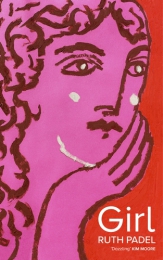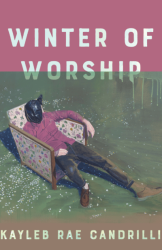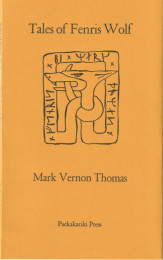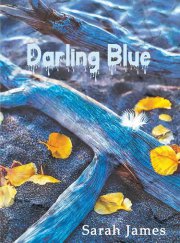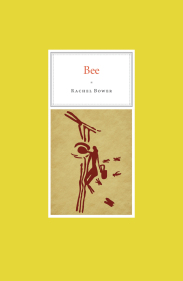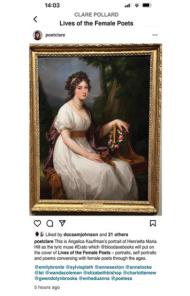
Ruth Padel, Girl, Chatto and Windus, 2024,
ISBN 9781784745806, 116pp, £12.99.
In this striking, incisive collection, Padel interrogates her readers’ implicit assumptions about girls and how so many people – not least the British Archaeologist Sir Arthur Evans – seek to ‘remake’ shards of history and personal desires into versions of girlhood. The final section of poems, ‘Lady of the Labyrinth,’ delves into one set of myths, relating to the Snake Goddess figurines in Crete, a brilliant arrangement of poems which engage with Ariadne, Psyche and other goddesses, sometimes in shapes that require you to follow, with your eye, the serpentine twining of meanings, sometimes by a witty use of contemporary allusion. Who could not be on board with the concept of ‘The World in the Shape of My Trainer Lee Newman Picks its Own Snake Goddess’? And when it comes to being charmed, the context to the poems (sometimes salted away in notes at the end of the book, and sometimes as epigraphs) can be, in itself, quite compelling: how did I live so long without knowing this: ‘ ‘Fascinate’ derives from the divine phallus, fascinum, a magic charm to ward off evil from boys and conquering generals’ (note to ‘The Enchantment’). Despite this protection, through Padel’s eyes, we are witnessing ‘the snowmelt/of the patriarchy’ (‘Maybe Ditch the Goddess’).
Pysche and Persephone appear also in the opening section, ‘When the Angel comes for You’, though these poems also show a cleverly oblique ‘re-making’ of the Biblical (and extracanonical) stories of the Virgin Mary, using subtle imagery to bridge the ancient narrative and the contemporary world where your child may be ‘hurt … falling off a sixth-floor balcony’ as much as being nailed to a cross. Padel draws on standard iconography, such as the goldfinch as an image of spiritual transformation, but also injects her own original twist. ‘They, But Not You, Receive the Gift of Tongues’ uses a flame shape to affirm that there is a chance for
‘transcendent
HTML in the form of fire’, ever wise to
‘the way
words follicle up together into living gold.’
The middle section of the book rests on more personal experiences of exploring girlhood, be it the starting realization that one’s mother was also once young (‘Mama and the Sea’) or the epiphnaic moment of transition from tomboy to suddenly wishing ‘I had curls’. Even here, though, we are never far from the canon of myths about some sort of Ewig-Weibliche, notably how so many elements of the natural world are depicted or conceived of as feminine (we have Mother Nature to blame for that, perhaps?)
Here is a collection that rich without ever being cloying, that occupies a middle ground between the personal and the universal. It invites you to consider ‘girl’ as verb, as having so much more agency than the stereotypes transmitted through the ages. It wears its learning lightly, and is both playful and profound; the sort of book to read and reread, and – if you can bear to risk losing it – passing on to friends to share the joy.
Hannah Stone
To order this book click here
Hannah Stone is the author of Lodestone (Stairwell Books, 2016), Missing Miles (Indigo Dreams Publishing, 2017), Swn y Morloi (Maytree Press, 2019) and several collaborations, including Fit to Bust with Pamela Scobie (Runcible Spoon, 2020). She convenes the poets/composers forum for Leeds Leider, curates Nowt but Verse for Leeds Library, is poet theologian in Virtual Residence for Leeds Church Institute and editor of the literary journal Dream Catcher. Contact her on hannahstone14@hotmail.com for readings, workshops or book purchases.
Kayleb Rae Candrilli, Winter of Worship, Copper Canyon Press, 2025, ISBN: 9781556596933, $17.00, 96 pages.
Kayleb Rae Candrilli’s new collection of poems, Winter of Worship, ends on the optimistic lines in a poem titled “To the Cherry Blossoms on 16th and Wharton”:
but here I am,
whole and sturdy and committed to spring
whenever it comes.
Just as in their previous collection, Water I Won’t Touch, Candrilli expresses sincere devotion to their partner, an attitude which is deepened by the generally elegiac tone throughout the collection.
The poem “A Marble Run for Another End-of Days,” a long, sprawling poem that is printed in landscape orientation on the pages it occupies, ends, “I have most things so dreadfully wrong, except standing nearer to midnight & loving my partner. Always, / it’s midnight & O bouquet of tulips dead on my counter, let me take that violence in my mouth, let me uncut your stems. Let’s just grow again.” Earlier in the poem (and certainly the title gives the game away), Candrilli writes of being “seasick with mortality” and notes with somber reflection that “Every field is a potter’s field.” But there is this one redeeming valuable thing.
There are three marble runs in Winter of Worship, a form created by Candrilli that is reminiscent of the pantoum in weaving together repeated lines and ending where it begins. (“A Marble Run for Another End-of-Days” begins: “O bouquet of steak knives, I want you to uncut your own steel stems & grow again.”). The marble run, named for a toy that links tracks potentially to infinity, is composed of three nine-line stanzas. In a note Candrilli further outlines the rules of the form, a brilliantly lyrical construction.
But the contrast of tones, the swing from ironic to sincere, from elegiac to triumphant, creates the predominant mood throughout. …and what is that mood? As they write in “All in Red”:
Nothing I feel feels new, instead
a raw and constant chafe, an always burning
yearn for the dead.
As in their previous collection, Candrilli writes about growing up in rural Pennsylvania, and again the tone swings from affectionate to grim, elegiac throughout. So much death! This is the kind of place that has been ravaged by the opiod epidemic, after all. One of those victims is Candrilli’s father. “I think about my family & still see the needle in my father’s arm,” they write in “A Marble Run for This Finite Earth” (“I wish my friends were still alive,” they write later in the poem), and in “Haibun for My Mother and the Early 2000s,” a title that already sounds elegiac, reflecting on their mother’s hardships, “even as she was resuscitating my father again—his face ashy until it wasn’t, his face dead until it wasn’t.”
“A Marble Run for Lights” begins with the ironic observation: “Such a cliché to write a poem for a dead friend.” Just as the title of “On Imagining Ariana Grande, Before the Fame, Working Every Summer at Rita’s Italian Ice” is saturated with irony, so when Candrilli notes that “some of us are dead,” meaning friends, they go on to say, “I regret // every unkind thing I’ve ever done,” a statement so laced with sincerity, after all that ironic distance, you’re left with the pure melancholy ache of shame.
“Another Poem about Cornfields” is an elegy for a dead friend and for the victims of the 2016 Pulse nightclub hate crime in which forty-nine people were killed. Remembering working in a hookah bar with the friend, Shana, Candrilli writes:
We shared Coricidin, Benadryl, and booze
too. We never spoke about the hurt behind
it all, because why bother. Some truths aren’t
even worth the breath. When you died, so did 49
other beautiful people in an Orlando nightclub.
The epigraph to Winter of Worship, from Louise Glück, is so on target: “Don’t listen to me my heart’s been broken. / I don’t see anything objectively.”
Climate change is also a concern expressed throughout, as Candrilli writes in “Elegy for the Not Yet Dead Rainforest Café,” “I cry in the winter, // when it isn’t cold at all and it should be.” Those cherry blossoms on 16th and Wharton in Philadelphia? They may just bloom early, killed, perhaps, by a late frost.
“Poem for the Start of a New Decade” takes place during the Covid pandemic. “The fragility of the world has always astounded me,” Candrilli writes. It’s another poem about loss and hurt, estrangement from family, people dying, and again the memories of that sad Pennsylvania town of their birth and youth.
My rural town always preferred to shoulder-check
the queer right out of you. If I concentrate, I can
still feel the very gay wind rushing from my solar
plexus. I can still feel the red-hot peat moss shoved
into my mouth.
But this poem, too, ends on a hopeful note, the swing from elegy to joy, in a reflection on the “perfect shape // of my partner’s engagement ring—upstairs in the filing // cabinet, just waiting for a calm, untroubling day.” May that day come soon.
Candrilli’s mother is seen as long-suffering and heroic throughout. “Daytona 500” starts with this ironic description of their small Pennsylvania town:
Where we’re from, we know ballet as Dale Earnhardt
gliding through the traffic of Daytona; we know dance
as our hands moving across a table of drunk Miller Lites.
This is universal because I say it is. When my mother called
me Kayleb the first time, I remembered the haunted house
on Clinton Hill, how she was tugged away by a hired actor.
I screamed until they took us out the fire escape. To care
is to call a name. To care is to call your mother’s name…
Candrilli writes in “I Wish I Were More Like My Mother” that “I would prefer to have remained
my mother’s daughter, too. But no
animal lingers while a brush fire
rages. Everyone tries to stay alive
vital and clawing just a little longer.
Needless to say, the life of a trans person is not easy. Candrilli alludes to these struggles in various places. In “Ghazal Written for the Lids in Downtown Brooklyn Where I Chose My Name,” they write, “Sometimes I still feel like a woman, and really, it’s not so bad if I’m alone.” In “One Hundred Demons” Candrilli tells us, “Please
know, most trans boys have spent their lives
swimming through the story of Peter Pan.
Tiger Lily, Captain Hook, and Peter—
Peter, young and boyish for all time.
But “Ghazals Connected as though Cargo Freights” defiantly concludes “My father was named after his father, and his father named after his. I named myself. Perhaps destiny / is a myth, and perhaps this myth is all we have. It’s time to call me by my name. Please don’t miss a sound.”
Winter of Worship strikes this delicate balance between hope and despair, and yet, here is Kayleb Rae Candrilli, “whole and sturdy…committed to spring.”
Charles Rammelkamp
To order this book click here
Charles Rammelkamp is Prose Editor for BrickHouse Books. His latest collection is The Trapeze Of Your Flesh (BlazeVOX Books).
Mark Vernon Thomas, Tales of Fenris Wolf, Paekakariki Press, 2023, ISBN: 978-1908-133-526, 26pp, £12.50.
I had the pleasure of reviewing Mark Vernon Thomas’ debut collection, Dancing with Shadows and Stones, for The Lake last year. Close on its heels comes another impressive book which displays all the features of his work I had cause to praise before: its energy, invention, range, sharp wit, precision and playfulness. In that previous collection the potential for longer works was teased. With Tales of Fenris Wolf, Thomas has realised that ambition with an integrated book length work, a hybrid of poetry and prose.
Thomas has been fortunate to secure Helen Moss to provide the artwork. Her illustrations do not merely embellish the text but embody it, replicating the vital surge of creativity to be found there. Executed with brush and ink and reminiscent of Chinese art, bold brush strokes result in pieces that possess a kinetic surge, veering between the figurative and the hieroglyphic.
While Moss’ illustrations alone would have made for an attractive book, the latter also has the added distinction of being a letter press production. Typset in 12 pt Monotype Garamond 156 on Neptune Soft White 120gsm paper, and with a wraparound cover, the book itself is a visual and tactile delight. To make it even more collectible, it is produced in a limited edition of only 250 copies.
Fenris Wolf is a key figure in Norse Mythology and one who has been much appropriated in popular culture over the years, most notably by Marvel Comics and in computer games. While Thomas’ sources are very much the original tales, do not expect a reverent reworking of Norse mythology. Tales of Fenris Wolf is subversive to the point of being mischievous. Readers might think they are in safe hands when they see on the first page a list of characters provided. However this reassurance is gleefully undermined when one skims down the list to find this entry: “Thor the Thunderer – he’s not in this one”. Another character, Dr Bowlby, locksmith is further defined as an attachment consultant. In a short essay which functions as an epilogue entitled ‘The true story of Fenris the Wolf’ we learn that “most of what we know about Fenris Wolf…comes from Snorri Sturluson, a 13th century Icelandic historian…a poet…a lawyer and a wealthy high ranking politician.” This leads Thomas to declare that “this makes him pretty much the definition of an unreliable narrator” and that it’s very likely “he wrote many of the stories we now see as central to the Norse mythological canon himself”. This in turn gives Thomas free rein to bend Fenris to his own agenda.
Fenris is very much cast as a figure of our times rather than one from a dim distant mythology. He consults with a careers officer (who suggests three options for Fenris: Librarian, IKEA assistant or Dogwalker.) He receives advice from an unidentified person in a laundromat (“Never mix whites and colours, all your stuff’ll go pink”). He gets to meet his mother, Angrboda, after a long separation but she is more interested in not missing her favourite television programme which is about to start. One gets the feeling it’s probably a soap. Ignoring the careers advice he received earlier, he attempts to break into the film industry as an extra – with disastrous results. Later he receives an unwelcome diagnosis from an attachment specialist: presumably this is the aforementioned Dr Bowlby. Fenris even tries Gestalt therapy to address his inner Odin, an elective action as mystifying as Tony Soprano exploring psychotherapy. Apart from these mock heroic elements, an underlying thread through the narrative is the threat of climate change and environmental destruction which is powerfully delineated, particularly in ‘Fenris begins to get hungry’, with its powerful anaphoric momentum:
for every pipeline on the tundra
for every hunting to extinction
for every grave dug in the forest
It is Fenris, however, who will eat the world. What places Tales of Fenris Wolf squarely in the 21st century is the parallelism between the gods who attempt to supress Fenris and the feckless and shady gods who currently lord it over us (to identify some of the latter does not require a lot of doom scrolling). Their sense of entitlement and arrogance seems unassailable but as Thomas points out, “gods are bound by their dreams and live in a predestined universe, powerless to change the script written for them…Putting our trust in gods and rulers is at best unreliable. Like all elites, they are concerned with themselves, only looking outward when they perceive a threat. The gods care no more for us than they did for Fenris”.
Forget the gods. Thomas is explicit in how we should view Fenris: “In a sense we are all Fenris, and he is us”. The book also contains its own subversion. Without giving too much away, because it would be an unforgiveable spoiler alert, it’s to be found in a short statement hidden in a discrete corner of the book. It does not wholly undermine The Tales of Fenris Wolf but definitely sets it vertiginously free. Enough said.
Although the expectation raised by the title is of a series of tales, a single narrative thread is discernible which charts Fenris’ life from a wolf cub until the moment he triggers Ragnarok, otherwise known as the twilight of the gods, when everything is destroyed, only to begin again, including Fenris himself.
This is not quite the end of the story however. A final chapter offers a low key curtailment of the narrative, after the bang a whimper, namely a rejection slip addressed to Mr Wofl (sic). Fenris it would appear is an aspiring author, placing him truly in the ranks of the unemployable, to paraphrase a sour judgement once made by Samuel Beckett.
Tales of Fenris Wolf is fun, punchy, entertaining and savagely satirical. Regardless of its source material, it is very much a work of our troubled and slippery times. This is definitely a book to buy.
David Mark Williams
To order this book click here
David Mark Williams writes poetry and short fiction. He has been shortlisted for the Montreal Poetry Prize and won Second Prize in the New Zealand Poetry Society International Competition. Two collections of his poetry have been published: The Odd Sock Exchange, Cinnamon, 2015 and Papaya Fantasia, Hedgehog, 2018.
